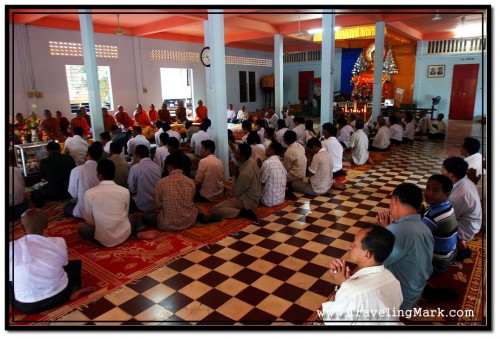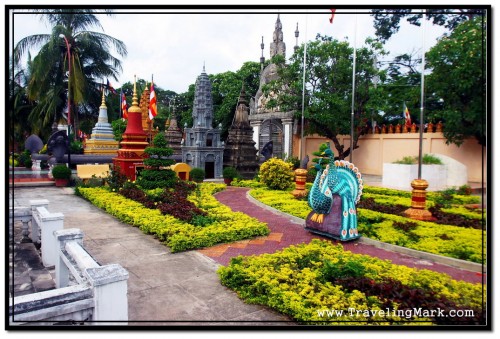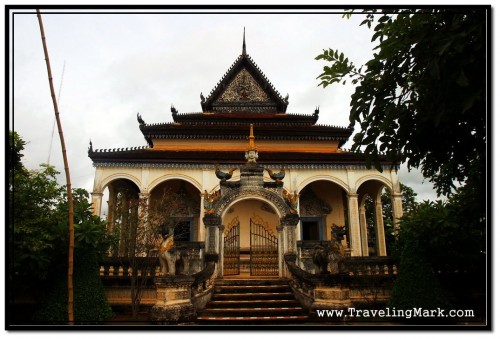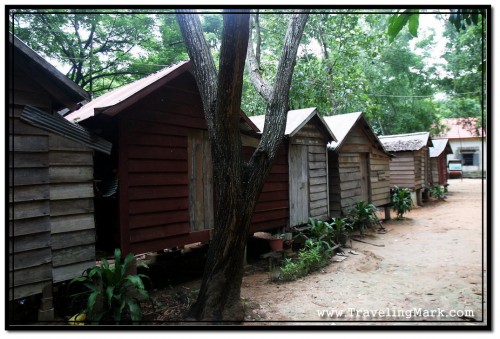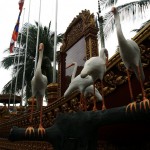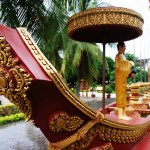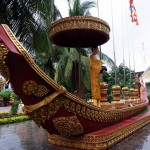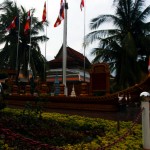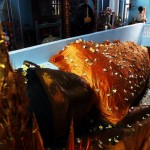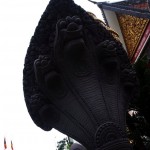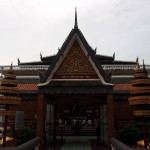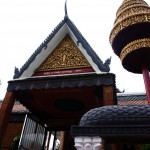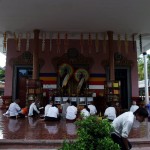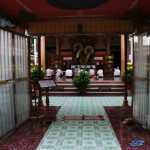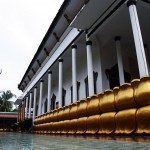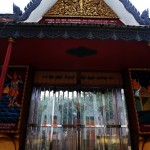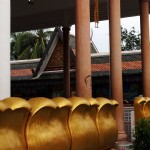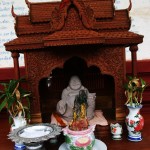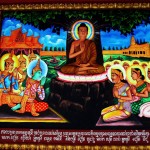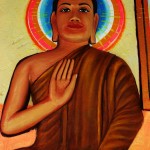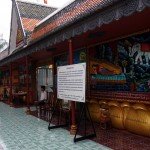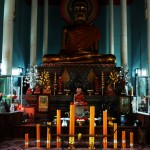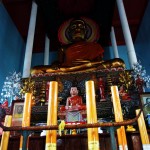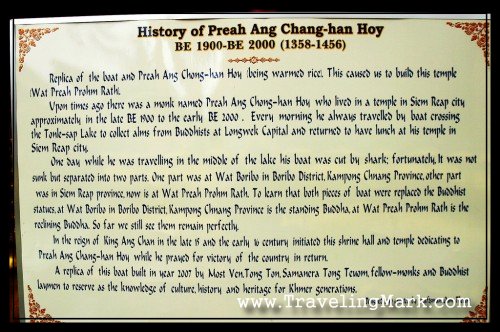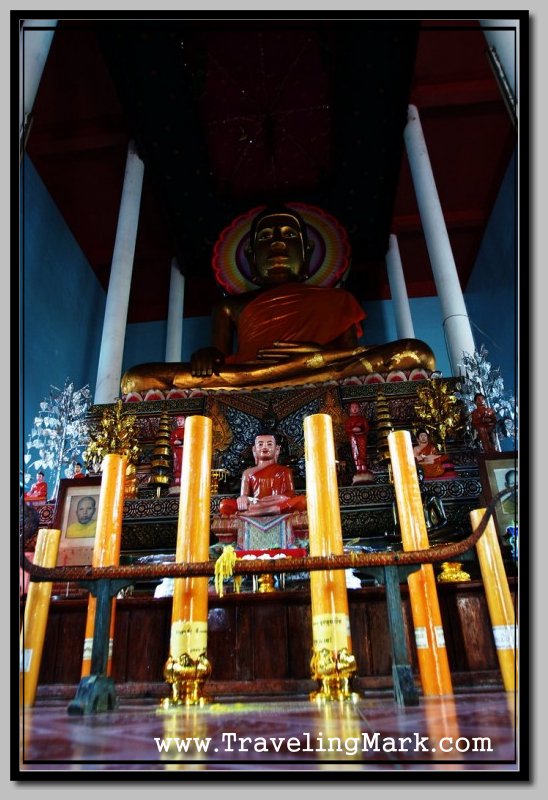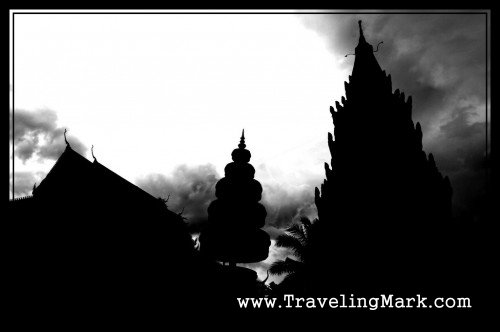This whole road trip idea was planned out to be a surprise for Ha and her daughter. I knew Ha couldn’t score a normal job in Cambodia – being both Vietnamese (keep in mind that Cambodians are extremely racist – just ask any Vietnamese person who’s ever visited Cambodia) and illegal to seek employment in Cambodia, so the only option she was left with was prostitution in Siem Reap‘s night clubs. However, the more time she spent with me, the wearier she kept getting of this whole idea of selling her body for money. Since she couldn’t have an actual job, Ha would the daytime with her daughter, as there was simply nothing other she could do. If I didn’t go to Angkor, she’d spend the day with me, but I needed to take advantage of good weather after waiting the rain out so I spent three consecutive days exploring the ancient temples, leaving the girls alone in Siem Reap.

I bought a 7 day pass to have enough time for even the more remote temples, but things went pretty smoothly so after three days, I had all of the temples on the Petit Circuit and the Grand Circuit covered, leaving me with 4 extra days to do the remote ones. The Petit and Grand Circuits are within main Angkor area where all of the famous and popular temples can be found, so by covering them all, I virtually had Angkor explored and everything on top of that would be an added bonus. One exception to this rule was the temple of Banteay Srei.
Banteay Srei
Banteay Srei temple is located about 25km from the main Angkor area (the area with where all famous and all biggest temple can be found – aka the area where most tourists go), however even though small in size, its intricate and elaborate carvings on red sandstone make Banteay Srei visually appealing so many organized tours include it in their itinerary. As a result, Banteai Srei, even though much smaller and significantly further away from Siem Reap, sees more visitors that Banteay Kdei – the temple on the Small Tour (Petit Circuit) where I made friends with villagers. While this is mostly a marketing pull on behalf of tour organizing companies, Banteai Srei did also gain notoriety among budget travelers which landed the temple a title of the “Jewel of Khmer Art”. As such, Banteai Srei is very overhyped and attracts tourists like honey attracts flies.
Needless to say – after being to all of the main Angkor temples, Banteai Srei was next on my radar. I knew Banteay Srei was 25 kilometers north of the main Angkor area, which all in all, would add up to being well over 30 km from Siem Reap, but since this part of Cambodia is completely flat, covering such distance on a bicycle wouldn’t be a problem. Sun and heat would be the biggest challenge, with potential of hostility from locals being close second. Afterall, being so far away from Siem Reap, all tourists who make it to Banteay Srei get there either in a bus as part of an organized tour, or by Tuk Tuk they hired in town. Omnipresent Tuk Tuks and motorcycles are fast moving and don’t draw much attention to themselves. Significantly slower moving bicycle with a foreigner on it, in an area of Cambodia far away from police patrolled streets of Siem Reap or Angkor… that sounded like a straight up death wish.

Road Trip
So instead of going all by me onesy on a bicycle, I decided to make my trip to Banteai Srei a Road Trip with guests and kill several birds with one stone. I could definitely do it on a bicycle, but after I took all other factors into consideration, the idea of a road trip prevailed. The undisputed advantages were:
1 – Tuk Tuk Ride
The idea of covering a long distance on a bicycle didn’t scare me. I was fit enough and enjoyed bike riding to the dot, but there were things in Cambodia a wise traveler never lets to slip his mind. But there was one even bigger reason why I had to consider a road trip on a Tuk Tuk and it goes back all the way to me teaching English at Wat Preah Prom Rath:
I have only been in Cambodia for less than 24 hours and I already taught a lecture in one of the classrooms at Preah Prom Rath. I enjoyed this experience profusely and was more than happy to volunteer my time to that cause as the students who attended the classes at the temple were ones who did not have a sponsor who would pay for a semester at a posh school. With me being part of their classes, they got more out of their lectures than students from incredibly overpriced schools such as the ACE – Australian Centre for Education. ACE – despite its high cost, is one incredibly useless school. If I were a parent of any of the kids who paid an incredible amount of money to attend that school, I’d demand a refund and get my kid the hell out of there. Most girls from the Sras Srang village where I ended up spending several months of my stay in Cambodia did attend ACE after sponsors paid for them, but day after day were forced to ask me to explain the lesson to them because they had no idea what it was about after attending a TESOL certified teacher lead class. After I explained it to them, then they understood, but there wasn’t one time in 5 months when any of the girls would return from the class and understand the topic of that day’s lecture.
Back to my English classes at Wat Preah Prom Rath – unfortunately for me, I came to Cambodia with an open mind and a will to dedicate myself to good causes. At the time, all one could find on the internet about Cambodia were utter lies. It took me all together 5 minutes to realize that Cambodians were hostile and that knowledge stayed from the moment I stepped foot on Cambodian soil, to the moment I left it. However even after being in the country for hours and already having experienced much of their hostility, I still lied to myself that there must be some good in Cambodia and if I keep my mind open, I would find it. It was a foolish thing to think.
Unfortunately, this type of mindset set me up for traps from which I could not get out of in the future. The students from my class instantly took advantage of the fact that I offered myself up to them with all openness and used each lecture to pressure me with business solicitations. As days went by and I realized that Cambodians are NOT those nice and friendly people travelers who fear reality make them to be, then I started to build a protective barrier between myself and the locals and didn’t allow anyone to take any more advantage of me, but this wasn’t until a few days after my arrival. During this first lecture of mine, as well as a few subsequent ones, I opened myself up and my students, instead of being grateful that I donated my time and knowledge to them for free, they took advantage of me and swarmed me with business hypes disguised as friendly chats. I reciprocated what I believed was merely an intention to have a friendly conversation with an English speaker, only to be forced into listening to pushy sales pitches from Tuk Tuk drivers and as they kept pressuring me and getting more and more in my face, the only way for me to escape was to eventually say OK to something.
They tried to force me into buying their services, but I told them I wanted to go for a walk that night so I couldn’t use them. Their response was that they would take me to see a sunset over a lake tomorrow then. And then that they would take me to the temples of Angkor. And then something again and again and again and again. From every angle, voices pressuring me more and more and cornering me and getting in my face until I had no choice but to say – “OK, I’ll let you know if I need a tuk tuk, G%$amn it!”
It was truly foolish of me to think that Cambodians would merely care to have a chat with someone from abroad. It’s not the case. It’s never been the case and not even after 5 months in Cambodia it ever happened to be one. But I wasn’t prepared for this to be a fact when I just came there and once a Cambodian forces you into even remotely implying something, then they’re gonna remind you of it day in and day out. And so they did remind me of that time when I said “OK”. Surprise!!!
Tuk Tuk drivers are an incredibly awful lot. They made every minute of my stay in Cambodia outside of my room a nightmare. If I had Ha with me, I could not finish a single damn sentence without one getting in my face and rudely interrupting. As a result, I would not give any of them any business just on principle. If I needed to go somewhere, I’d rather walk in that heat than give a Tuk Tuk driver a penny. Needless to say, they would still bother the living crap out of me, but at least I wouldn’t pay them anything. So it was not easy to actually get one on my own terms and offer him a gig of taking me to Banteay Srei for a road trip. But since this would shake off one of the traps Cambodians caught me in when I was too trusty, I said – why not?
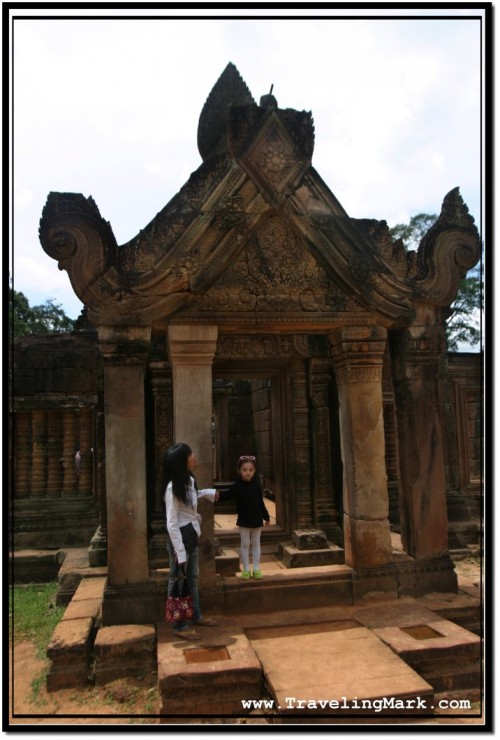
2 – Fun Day for Ha and Her Daughter
Hellz yeah – to Ha and her daughter, every day was a struggle to survive (as it was for me, but for completely different reasons) with basically no chance to do anything fun. To Ha, every morning started with thoughts of worry about how she was going to buy food for her little girl. When simple day to day survival becomes your #1 priority, you don’t have the resources to buy basic necessities beyond food, let alone take your kid on a road trip. And knowing darn well how much hardship Ha and her daughter already went through, I instantly realized that affording them a simple day of simple joy would mean the world to them.
And this was the main reason why I opted for a road trip on a tuk tuk, rather than a self ride on a bicycle to Banteai Srei. A tuk tuk can seat up to 4 people easily, so taking Ha and her daughter along wouldn’t cost me any more than going on my own. And even though had I not met Ha, I would still have gone by bicycle, despite pressure from my students, knowing that by taking Ha and her daughter out for a day of fun, I could visit an extra temple without risking a ride through potentially hostile territory, and I would shake off the obligation my students forcibly placed upon me, I saw nothing but pure WIN for everyone in this arrangement.
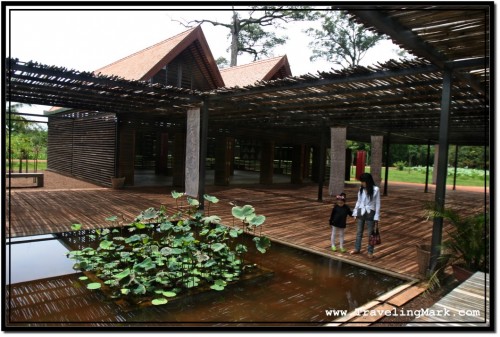
The only trouble was that the night prior to intended road trip I did not make it to the class, because I stayed at Angkor Wat for night photography. I already had my present for Ha’s daughter with me, but I really wanted to make the day when I give it to her even more special. I wanted to take them away from the worries they experience every day and set their mind on something positive – while they are together, and myself with them. So despite being exhausted and wet (it rained like all hell during my nighttime stay at Angkor and I rode back home in that rain), instead of heading home to take shower and relax a bit, I headed straight for Pub Street and started looking for a tuk tuk driver from my class. Since Pub Street is where majority of foreigners who stay in Siem Reap go after dark, that is where majority of Siem Reap’s tuk tuk drivers aggregate after dark. I knew I stood a decent chance of finding him there as ratio of tuk tuk drivers to foreigners in Siem Reap is rather unfavorable (more tuk tuk drivers than tourists).
Luckily for me – he was there, hiding from the rain under the roof of his tuk tuk. I made arrangements with him, told him when and where to come the following day and told him where and how many of us are going. All set and done, I was ready to go to my room, make myself human again and head over to the Temple Club to meet with Ha so I could take her home with me for a warm shower and comfy sleep. I told her not that I had a gift for her daughter and that after the gift, I was taking them for a road trip to Banteay Srei. I kept it a surprise until the last moment and it paid off big time. Not only did the girls have their first worry free, fun day in a long time, it was also the first time for the little girl in years to feel like she had a father. I may not have made her, but she was in daddy’s arms the whole time. I do not have the words to describe how much it meant to them and to me, but what I got back in child’s laughter and mother’s tears has made an impact you can’t replicate.

